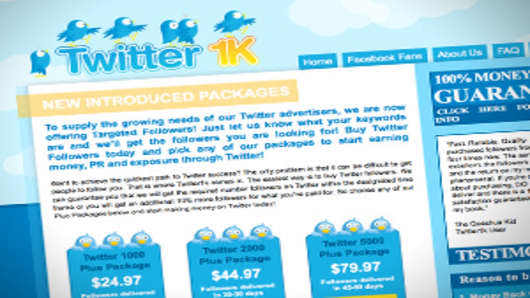Got $500? If so, you could be a very popular person on Twitter.
While the social network can be a powerful platform to build brands and reputations, building up a network of followers takes time – even for the famous and powerful. But for some impatient users, it's easier to simply take a shortcut and buy followers.
It's an accusation that's dogging Newt Gingrich these days. After the presidential candidate bragged about his 1.3 million Twitter followers recently, gossip blog Gawker cited data from search engine firm PeekYou that the vast majority of those followers weren't real. The Website quotes a person it identifies as a former Gingrich staffer as saying the accounts were purchased.
Buying Twitter followers is an old practice – and a fairly easy one – but it's one that reputable social media strategists say is unethical.
"Obviously, it's frowned upon," says Kellye Crane, of Atlanta-based Crane Communications. "Anyone who's trying to buy followers is looking for a quick fix."
There are dozens of services online that let people buy followers. Prices start at about $15-$20 per thousand, with bulk orders costing less – 50,000 followers will typically run less than $500. Those followers, though, are often dummy accounts run by computers, some in a very obvious way, some in a more sophisticated fashion.
Twitter accounts, after all, are simple to build. The low-rent district of fake and bought ones generally are pages that have no picture of the user, no bio and no original Tweets. Even an amateur can spot those. Some companies, though, add that information – and regularly have a computer update the account with generic updates, retweets and what appear to be replies to other users (though, if you dig into those replies, you'll often find that the user they're 'replying' to isn't a live Twitter account).
In the early days of Twitter, it was considered polite to follow anyone who followed you. Some users still follow that decorum – and unwittingly get sold in the process. Some 'follower for sale' services have done extensive searches on Twitter to find those people and take advantage of that mindset.
The companies temporarily take the reins of their client's account and follow a specified number of those people. Once those users have reciprocated, the sales company typically does a mass unfollow, leaving the client feed clean and its follower count high.
Experts say the people and companies who buy followers are typically those who don't really understand the social network.
"Anyone who's trying to buy followers is looking for a quick fix."
"If you're not familiar with Twitter and someone says I can have 10,000 people follow you, that sounds great," says Mack Collier, a social media strategist and trainer (and frequent speaker at events like South by Southwest Interactive). "They're not going to talk to you about how to use Twitter to meet your goals and objectives. … When we don't really understand something, we go back to 'what's the number?' The biggest number always wins until we understand how something works – especially with social media."
The fact is that follower numbers matter little on Twitter. More important are how engaged those followers are with what you're saying. That's why services like Klout, which measures a user's influence over their social network, are seeing their star rise. Rather than focusing on followers, Klout examines how people react to Tweets and the actions those microblogs generate (such as retweets, @messages, comments and more).
No one really knows how big the market is for paid Twitter followers. There are a lot of companies involved in the practice and no consultant will ever admit to using them. Experts, though, say they believe it's becoming a less common occurrence as Twitter becomes more understood by the business world and the mass audience.
"It's not happening as much as it used to," says Collier. "When Twitter was just starting to become popular, people were scrambling to find out who the influencers were – and number of followers is all you could look at. It's a numbers game. I think we're getting away from that."
The numbers game does work occasionally, though. Blasting your message out far and wide, with little regard to who's listening, is one of the oldest marketing tricks in the book.
"It's like direct mail," says Scott Olson, president of MindLink Marketing. "You're sending out your message to potentially millions of people, but you only need a response rate of less than 1 percent from that [group] to make it pay off. This, in some ways, might be similar to buying a marketing list."
Crane notes that the practice is also similar to another, more recent marketing trick – known in the industry as "astroturfing".
"Sometimes a company would create a fake blog that has a positive point of view about their product or service," she says. "They're trying to put a positive spin out there and they're trying to make it sound like a grass roots communication from a real person."
Ultimately, though, buying followers is often a vanity exercise. People who want to be seen as influencers – or companies who don't want to look small compared to their competitors (who may have gotten a headstart on the service), want to quickly boost their numbers to appear relevant.
"Let's face it, we're trying to be hip," says Crane.



